Thursday, February 02, 2006
Monday, January 30, 2006
Sponsorship information and options
 (Image reproduced from the World Vision website with their kind permission)
(Image reproduced from the World Vision website with their kind permission)- Population: 36m
- Life expectancy: 43.5 years
- 165 of every 1,000 children die before their 5th birthday
- 29% of under 5s are underweight for their age
- 22.9% of the adult population can't read or write
- 32% of the population don't have access to safe clean water
- 8.8% of the adult population are infected with HIV/AIDS
Any sponsorship we can raise from this Kili50 effort will specifically benefit the Kisiriri Area Development Project, a remote area in the central north of Tanzania, comprising the children and families in 19 villages. More details of the actual World Vision projects in Kisiriri ADP that your sponsorship will help will follow as the year progresses, but rest assured that the total target of £25,000 will change lives. What I like about World Vision is that they encourage local communities to help themselves over the long term, rather than throw money at a problem and hope for a short term solution, and disappear...the ADP started in 2004 and will be supported by World Vision for the next 15 years
 I realise that I'm visiting their country just for a personal whim and that the cost of the trek represents more money than most Tanzanians can ever dream about...but hopefully raising £25,000 to benefit very specific projects in a small area of the country will at least give a little back to the country with a Very Big Mountain
I realise that I'm visiting their country just for a personal whim and that the cost of the trek represents more money than most Tanzanians can ever dream about...but hopefully raising £25,000 to benefit very specific projects in a small area of the country will at least give a little back to the country with a Very Big Mountain
I might have very different feelings after the attempt, of course, but right now I would appreciate any support you can give for the Kili50 initiative
And you can follow the Kili 5's efforts by bookmarking this Blog site now. Take a look at some previous articles to see the majesty of the mountain and its 5 distinct zones; my disastrous commute getting me out of circuits; the wonders of VO2MAX; why we're taking the Machame route...and going forward see how fit Steve is by the end of the year (he's progressed to walking to the car this month), how our Snowdon jaunt pans out, how the sponsorship effort goes...and much much more thrilling stuff
And finally, if any of this inspires you rather than makes you feel a bit queasy with the worthiness (and challenge) of it all, then it's not too late! But it soon will be. There are just a few places left in the Explore group leaving on February 23, 2007 with the Kili 5 in it
Ok, this really is the last word...please email this Blog link to all your contacts so that they can hopefully sponsor and send on to their own contacts. We need all the help we can get to raise the £25,000
The Cotswold Rollercoaster
 Time for my first appearance on this blog, I think. Andrew's entries have already set high standards, and I have doubts this will live up to them. (He's also an accomplished flatterer and embroiderer-of-truths, too, it seems. His suggestion that I'll "meander up Kili barely breaking sweat" certainly isn't borne out by any recent experience of strenuous activity that I've had, such as going upstairs, or walking to the shops.)
Time for my first appearance on this blog, I think. Andrew's entries have already set high standards, and I have doubts this will live up to them. (He's also an accomplished flatterer and embroiderer-of-truths, too, it seems. His suggestion that I'll "meander up Kili barely breaking sweat" certainly isn't borne out by any recent experience of strenuous activity that I've had, such as going upstairs, or walking to the shops.)Yesterday—Sunday—saw Eszter and I exploring the badlands of the Southern Cotswolds, doing a few miles round St Catherine's and Charmy Down. The Southern Cotswolds are rather the poor cousin of their more northerly relatives—eg, the better known chocolate-box picture areas around Stow-on-the-Wold and Bourton-on-the-Water—which is a shame, as they're no less enchanting. I suspect they suffer from having Bath as a very near neighbour.
The Cotswolds may not be the first area that comes to mind for alpine training. However, whilst the whole area we walked in doesn't rise much above 200m, it demonstrated a remarkable ability to go steeply up and down a lot, and, when not going up or down, to be very muddy. On one occasion it contrived to showcase its talents by being steeply uphill and muddy.
Our route took us along part of the Limestone Link, a 36 mile path linking the Cotswolds to the Mendips, which follows the Kennet & Avon Canal for some of its way. (Incidentally, the Kennet & Avon canal has a major place in the history of geology. The Resident Engineer was no less a man than William "Strata" Smith, who—fascinated by the layered rock formations that were revealed as the canal was excavated—devoted his life to geology, producing the world's first true geological map. But I digress...)
We started from Cold Ashton (at the top left of this map), which has an imposing manor house, and a stunning view - the picture below really doesn't do it justice. From there it was immediately downhill, and into the first mudhole of the day, crossing one of numerous streams and spring run-offs that would feature quite prominently during the afternoon.

Mud and navigational issues aside, meandering through rolling meadows and tree-lined hollows, on a beautifully sunlit and surprisingly warm late-January day, isn't a bad way of spending a Sunday afternoon. I'm sure it's actually true of many countries, but there does seem something quintessentially English about having expanses of idyllic countryside only a short drive away from massive conurbations. There's also something quintessentially English about the fact that very few people in the latter take the trouble to visit the former.
The return half of the circult was over Charmy Down, an old RAF airfield now littered with disused buildings, and cows. Actually, that sentence should start "The return half of the circuit when you can actually find out how to get to it...". Yes, the public footpath is marked on the map, and yes, some nice people helpfully told us to "turn right over the bridge". However, the footpath isn't signed at all, and there are two bridges within 20 yards of each other, both of which appear to lead into someone's front garden. After some nervous reconnaisance, half-expecting to be shouted at for trespass, the path was discovered up a dark, narrow alleyway, next to someone's back door, hidden behind a small metal gate. All that was missing was a sign saying "Beware of the Leopard".
This was also the point at which the going got both steep and muddy, with "steep" being the rather more operative word of the two, the path climbing from about 40m to 180m in half-a-kilometre—an average gradient of over 25%, or 1-in-4 in real money. This turned out to be an excellent way of simulating the effects of altitude, at least to the extent of inducing oxygen starvation and incipient exhaustion in a worryingly short space of time. Fair enough, "wold" does mean "rolling", but you do get the feeling that the Cotswolds play fast-and-loose with the term—more rollercoaster than rolling.
Reaching the plateau of the Charmy Down therefore came as a great relief—at least until the fact it is a plateau allowed the rather bitter winter wind to rip through us. (Incidentally, why is it that to reach anywhere called "Down" you almost invariably have to go up?) The windswept airfield is now populated mainly by cows rather than Spitfires and Hurricanes awaiting the order to "scramble", although aircraft do still put in an appearance in the form of microlites and model airplanes.
The cold wind, and the fast-setting sun, contrived to drop the temperature several degrees, which was probably the main reason we elected to take the shorter route back to Cold Ashton, straight across the middle of the old airfield, rather than going right round the edge and then back past Monkswood reservoir.
The last leg of the circuit was pretty easy-going compared with the rest—even to the extent of (unavoidably) being along tarmaced roads at the end. We made it back to the car about 3½ hours after leaving it, and not long before the sun finally set. Okay, it was hardly an expedition to Everest Base Camp, but it certainly made us both ready for the curry (a thankfully mostly pre-cooked curry, having made an excess the night before) that was waiting for us at home.
Sunday, January 29, 2006
Targets, targets, targets
 If the truth be told I drifted through the first 30 (OK...40) something years of my life somewhat aimlessly. Underachieving, I'll probably admit. I suppose I've done OK and I'm not complaining, but one thing that has finally sunk in is that I always need a target. Focus. Something very specific to strive towards
If the truth be told I drifted through the first 30 (OK...40) something years of my life somewhat aimlessly. Underachieving, I'll probably admit. I suppose I've done OK and I'm not complaining, but one thing that has finally sunk in is that I always need a target. Focus. Something very specific to strive towards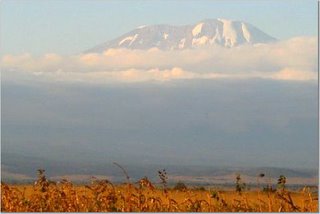
Here's what I got from a very pleasant 30 minutes with Julie:
Height: 181cm (target = 185cm)
Weight: 73kg (hmmm...I've been 75kg for years now. Not sure why I've dropped a couple of kg recently, especially after a lot of rum punch and jerk chicken at Christmas). Might need to bulk up a bit to get my puny frame up 5,895m in sub zero temperatures
Blood pressure: 118/74mm/Hg. Fine. 118/74 compared with the normal (120/80) range. Stick to a healthy diet, minimising the intake of saturated fats and keep up with your regular aerobic exercise. There's no saturated fat in the weekend bacon butties, right?
Body fat: percentage body fat refers to the proportion of your body fat that is comprised of fat. Your assessment indicated a level of 18.1% which is within the recommended range of 14-20%. Really push yourself on the cardiovascular machines...at the end of the day the harder you work, the better the results will be.Thanks, Julie, but sometimes I just don't feel like really pushing myself on the treadmill after a long day sweating for The Motley Fool and wrestling with South West Trains
Flexibility: this is an important factor for injury prevention and to assist in day to day activities. Your flexibility in the sit and reach test, particularly in the hamstrings could be improved. You obtained 20 cms, which is below the minimum range (22-31 cms) for your age. Flexibility can be increased by taking more time to stretch properly before and after exercise. Oops. This one hurt. I'm blaming the pathetic hamstring bendiness on my bad back...but I know I've never stretched properly before or after exercise, I just want to get on with it. Definitely a could do better area. I'll aim for an ambitious improved target of 24 cms
Stamina (aerobic fitness): basically the ability of the heart, lungs and rest of the cardio respiratory system to deliver oxygen to the exercising muscles.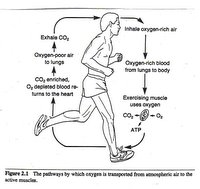 From the test we carried out on the treadmill I have worked out your aerobic fitness (running comfortably on the treadmill for 1 mile / 1.6 km while hooked up to a heart monitor thing...I think it took me about 8 minutes) and my heart rate at the finish was 139 bpm
From the test we carried out on the treadmill I have worked out your aerobic fitness (running comfortably on the treadmill for 1 mile / 1.6 km while hooked up to a heart monitor thing...I think it took me about 8 minutes) and my heart rate at the finish was 139 bpm
VO2MAX = maximum oxygen uptake (ml/kg/min). In other words the maximum capacity of oxygen you can get to your muscles in ml, per kg of body weight per minute. You obtained 57.5 ml/kg/min, which is in the EXCELLENT category for your age group (40+) so you should be very pleased. Too right I'm pleased, Julie...this is going to be crucial to try and get to Kili's summit where we'll have less than half of our normal oxygen intake, apparently. Hoorah
Here's how you can work out your own VO2MAX in the future (are you ready for this?):
108.44 - (0.164 x weight)(kg)) - (1.438 x mile jog time (m)) - (0.193 x final heart rate)
This formula is for the guys, by the way, so get measuring, Jon & Steve. I'm targeting a significant improvement, but not quantifying it yet! Obviously the higher it is the more oxygen you can uptake and the fitter you are
I'm trying to persuade Gill to take a similar test to benchmark her own fitness level, and hopefully she can get the girlies' VO2MAX magic formula if she & Est are vaguely interested in any of this mumbo jumbo
Water: for the amount of exercise you do your water percentage was good. You were within the recommended range (55-65%) with 60.1%. It is recommended that for an active person two and a half litres of water should be drunk per day. Apparently this water intake is absolutely critical during the Kili climb...if you don't drink enough you'll dehydrate and don't stand a chance of dealing with the altitude. And of course if you do drink enough you spend half the day peeing. Which is a good thing because it forces you to rest a lot
Conclusion: your aerobic fitness is excellent so just work at maintaining that. Your flexibility should be improved though just remember to stretch properly before and after your workout sessions and hold your cool down stretches for longer than your warm up stretches. Other than that, continue what you're doing. Well done, keep up the good work. And of course you're allowed 4 pints of lager and a curry every Friday, Saturday and Wednesday night
OK, I made up that last bit but otherwise not too shabby for an old git, eh? Still got something to aim for in the next 13 months so that I've got a fighting chance of summiting Kili, though. Thanks, Julie for an enjoyable and thought-provoking experience. The fitness assessment was OK, too
I hope that when I look back at this article and measurements this time next year I'll be on the right track...and maybe the rest of the Kili 5 would like to record some of their own stats to benchmark their progress. Or not. But everyone needs a target, right.....?

Meet the mountain

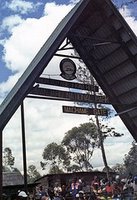 (Our Machame route starts at Machame Gate at 1,800m altitude but we'll experience the lower slopes during the drive from the town of Moshi to the start of our trek. More on the detail of our scary itinerary in a later article)
(Our Machame route starts at Machame Gate at 1,800m altitude but we'll experience the lower slopes during the drive from the town of Moshi to the start of our trek. More on the detail of our scary itinerary in a later article)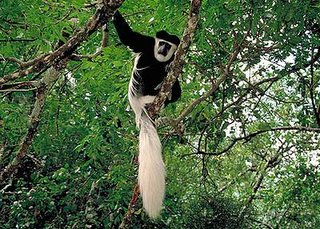
3. Heath and moorland
Between 2,800-4,000m are overlapping zones of heath and moorland, with rainfall ranging from 1,300mm (50 inches) a year on the lower slopes to 500mm (20 inches) higher up. Frost forms at night, and intense sunshine makes for high daytime temperatures
Heather and allied shrubs are well adapted to these conditions, the giant heathers (Erica arborea) having tiny leaves and thick trunks and growing to 3 metres high. You'll also see red hot pokers (Kniphofia thomsonii) standing to attention, and colourful Helichrysums
The moorland is dominated by giant groundsels (senecios and lobelias), especially near water courses. The most striking is Senecio kilimanjari, which grows up to 6 metres tall
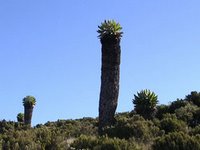
The animal you are most likely to see is the tiny, semi-tame four-striped grass mouse (Rhabdomys pumilio), which has found its niche around the Horombo huts. From just above the forest upward, you will often see and hear the harsh croak of the white-necked raven, which scavenges successfully from the huts
4. High desert
The montane (high or alpine) desert zone stretches from 4,000m-5,000m and has low precipitation, less than 250mm (10 inches) a year. Here summer burns every day with mid-day temperatures of 35-40C (throw another shrimp on the barbie, Steve), whilst at night the winter chill bites deeply (unpack the long johns, Mrs M). Soil is scanty, and what little there is can be affected by solifluction; when the ground freezes, it expands and flows, disturbing plant roots. Only the hardiest can survive, such as the long-lived lichens (and hopefully The Kili 5)
The few plants that survive are slow-growing so care should be taken not to damage them
5. The summit zone
Higher up it is colder and drier still, and the slight precipitation (under 100mm or 4 inches a year) falls mainly as snow. This often condenses from clouds sucked up from below when air pressure drops because of the warming effect of the sun. There is no liquid water on the surface: it disappears into porous rock or is locked in as ice and snow

Living things must not only endure the blazing equatorial sun by day, but also arctic conditions by night. Here altitude defies latitude. With deep frosts, fierce winds, scarce moisture and less than 50% of the oxygen available at sea level, the environment is deeply hostile to any kind of life. Remind me why we're attempting this again.....
The highest flowering plant ever recorded was a small helichrysum in the crater at 5,670m. Animals are very rare, although in 1926 Richard Reusch found and photographed a snow leopard frozen in the snow. Hemingway immortalised it in his 1938 short story The Snows of Kilimanjaro, remarking that "no one has explained what the leopard was seeking at that altitude"
So there you have it. 1 mountain. 5 zones. A world of extremes. All in a week. Sounds amazing and scary in equal measure, eh? Stay tuned to this blog to see how we progress over the next 13 months until next February and the most interesting date any of us have probably ever been on (apart from when we met in The Old Emporium in Fleet obviously, Gill)

